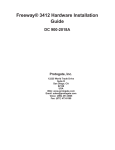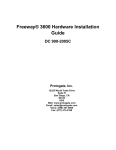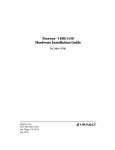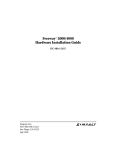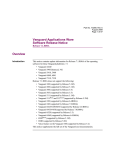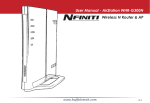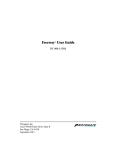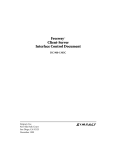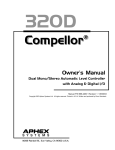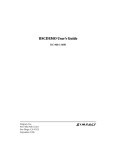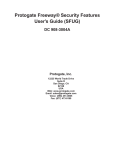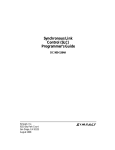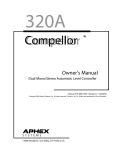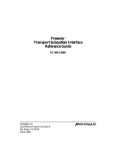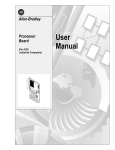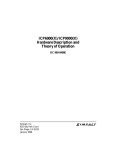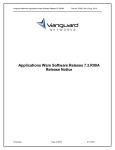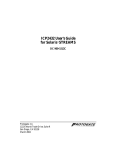Download Simpact Freeway 1150 Installation guide
Transcript
Freeway ® 1200/1300 Hardware Installation Guide DC 900-1537B Simpact, Inc. 9210 Sky Park Court San Diego, CA 92123 November 1999 Simpact, Inc. 9210 Sky Park Court San Diego, CA 92123 (858) 565-1865 Freeway 1200/1300 Hardware Installation Guide © 1999 Simpact, Inc. All rights reserved Printed in the United States of America This document can change without notice. Simpact, Inc. accepts no liability for any errors this document might contain. Freeway is a registered trademark of Simpact, Inc. All other trademarks and trade names are the properties of their respective holders. Contents List of Figures 5 List of Tables 7 Preface 9 Safety Precautions 15 Freeway 1200 Certifications 21 Freeway 1300 Certifications 25 1 Getting Started 29 2 Hardware Installation 31 3 Configuring the Boot Parameters using the Initialization Disk 43 4 Configuring the Boot Parameters using the Local Console 51 A Electrical Interfaces 61 B Freeway 1300 LED Panel and Alarm Functions 63 C Replacing the Power Supply in a Freeway 1300 67 Index DC 900-1537B 71 3 Freeway 1200/1300 Hardware Installation Guide 4 DC 900-1537B List of Figures Figure 2–1: Front View: Freeway 1200 (lockable door not shown) . . . . . . . . . . . 34 Figure 2–2: Front View: Freeway 1300 (lockable door not shown) . . . . . . . . . . . 35 Figure 2–3: Example Back View: Freeway 1200 . . . . . . . . . . . . . . . . . . . . . 36 Figure 2–4: Example Back View: Freeway 1300 . . . . . . . . . . . . . . . . . . . . . 37 Figure 2–5: ICP Numbering: Freeway 1200 . . . . . . . . . . . . . . . . . . . . . . . 39 Figure 2–6: ICP Numbering: Freeway 1300 . . . . . . . . . . . . . . . . . . . . . . . 40 Figure 3–1: Example of the Freeway System Boot Parameters . . . . . . . . . . . . . 45 Figure 3–2: Configured Freeway System Boot Parameters . . . . . . . . . . . . . . . 48 Figure 4–1: Freeway Boot System Main Menu . . . . . . . . . . . . . . . . . . . . . . 54 Figure 4–2: Example of the Freeway System Boot Parameters . . . . . . . . . . . . . 55 Figure 4–3: Configured Freeway Boot Parameters . . . . . . . . . . . . . . . . . . . . 60 Figure B–1: Front Panel: Freeway 1300 (lockable door not shown) . . . . . . . . . . . 63 DC 900-1537B 5 Freeway 1200/1300 Hardware Installation Guide 6 DC 900-1537B List of Tables Table 3–1: Freeway System Boot Parameters. . . . . . . . . . . . . . . . . . . . . . . 45 Table 3–2: Flags for Reset Action . . . . . . . . . . . . . . . . . . . . . . . . . . . . . 47 Table 4–1: Freeway System Boot Parameters. . . . . . . . . . . . . . . . . . . . . . . 56 Table 4–2: Flags for Reset Action . . . . . . . . . . . . . . . . . . . . . . . . . . . . . 58 Table A–1: Commonly Used Electrical Interfaces . . . . . . . . . . . . . . . . . . . . 61 DC 900-1537B 7 Freeway 1200/1300 Hardware Installation Guide 8 DC 900-1537B Preface Purpose of Document This document describes the hardware installation procedures for Simpact’s Freeway 1200/1300 communications server. It is used in conjunction with the Freeway User Guide, which describes the software installation procedure. Intended Audience This document should be read by the computer technician who will be installing the Freeway communications server. System administrators and system integrators may also find it useful. The “Required Equipment” section was intentionally moved to Chapter 2. 4/20/99: I changed the spacing above Organization of Document The “Safety Precautions” section on page 15 describes important safety guidelines that you should review before beginning the installation. The “Freeway 1200 Certifications” section on page 21 shows the certifications for the Freeway 1200. The “Freeway 1300 Certifications” section on page 25 shows the certifications for the Freeway 1300. Chapter 1 is an overview of the Freeway installation procedure. Chapter 2 describes the hardware installation. DC 900-1537B 9 Same: 3100/3150, 3200/7200, 1200/1300 Freeway 1200/1300 Hardware Installation Guide Chapter 3 describes how to configure the boot parameters using the boot parameter initialization disk. Chapter 4 describes how to configure the boot parameters using the local console. Appendix A shows the commonly used electrical interfaces. Appendix B describes the Freeway 1300 LED panel and alarm functions. Appendix C describes how to replace a power supply in the Freeway 1300. 10/19/99 Leslie: Add 1566 Addendum to 1501, and add “Freeway” to title of 1533. Simpact References The following general product documentation list is to familiarize you with the available Simpact Freeway and embedded ICP products. The applicable product-specific reference documents are mentioned throughout each document (also refer to the “readme” file shipped with each product). Most documents are available on-line at Simpact’s web site, www.simpact.com. General Product Overviews • • • • Freeway 1100 Technical Overview 25-000-0419 Freeway 2000/4000/8800 Technical Overview 25-000-0374 ICP2432 Technical Overview 25-000-0420 ICP6000X Technical Overview 25-000-0522 Hardware Support • • • • • • • 10 Freeway 1100/1150 Hardware Installation Guide DC-900-1370 Freeway 1200/1300 Hardware Installation Guide DC-900-1537 Freeway 2000/4000 Hardware Installation Guide DC-900-1331 Freeway 8800 Hardware Installation Guide DC-900-1553 Freeway ICP6000R/ICP6000X Hardware Description DC-900-1020 ICP6000(X)/ICP9000(X) Hardware Description and Theory of Operation DC-900-0408 ICP2424 Hardware Description and Theory of Operation DC-900-1328 DC 900-1537B Preface • • • ICP2432 Hardware Description and Theory of Operation DC-900-1501 ICP2432 Electrical Interfaces (Addendum to DC-900-1501) DC-900-1566 ICP2432 Hardware Installation Guide DC-900-1502 Freeway Software Installation and Configuration Support • • • • Freeway Message Switch User Guide DC-900-1588 Freeway Release Addendum: Client Platforms DC-900-1555 Freeway User Guide DC-900-1333 Freeway Loopback Test Procedures DC-900-1533 Embedded ICP Software Installation and Programming Support • • • • • • ICP2432 User Guide for Digital UNIX DC-900-1513 ICP2432 User Guide for OpenVMS Alpha DC-900-1511 ICP2432 User Guide for OpenVMS Alpha (DLITE Interface) DC-900-1516 ICP2432 User Guide for Solaris STREAMS DC-900-1512 ICP2432 User Guide for Windows NT DC-900-1510 ICP2432 User Guide for Windows NT (DLITE Interface) DC-900-1514 Application Program Interface (API) Programming Support • • • Freeway Data Link Interface Reference Guide DC-900-1385 Freeway Transport Subsystem Interface Reference Guide DC-900-1386 QIO/SQIO API Reference Guide DC-900-1355 Socket Interface Programming Support • Freeway Client-Server Interface Control Document DC-900-1303 Toolkit Programming Support • Freeway Server-Resident Application and Server Toolkit Programmer Guide DC-900-1325 • • OS/Impact Programmer Guide DC-900-1030 Protocol Software Toolkit Programmer Guide DC-900-1338 Protocol Support • • ADCCP NRM Programmer Guide DC-900-1317 Asynchronous Wire Service (AWS) Programmer Guide DC-900-1324 DC 900-1537B 11 Freeway 1200/1300 Hardware Installation Guide • • • • • • • • • • • • • AUTODIN Programmer Guide DC-908-1558 Bit-Stream Protocol Programmer Guide DC-900-1574 BSC Programmer Guide DC-900-1340 BSCDEMO User Guide DC-900-1349 BSCTRAN Programmer Guide DC-900-1406 DDCMP Programmer Guide DC-900-1343 FMP Programmer Guide DC-900-1339 Military/Government Protocols Programmer Guide DC-900-1602 N/SP-STD-1200B Programmer Guide DC-908-1359 SIO STD-1300 Programmer Guide DC-908-1559 X.25 Call Service API Guide DC-900-1392 X.25/HDLC Configuration Guide DC-900-1345 X.25 Low-Level Interface DC-900-1307 Document Conventions The term “Freeway” refers to either of the Freeway models, 1200 or 1300. Revision History The revision history of the Freeway 1200/1300 Hardware Installation Guide, Simpact document DC 900-1537B, is recorded below: Document Revision 12 Release Date Description DC 900-1537A July 1999 Original release DC 900-1537B November 1999 Added new flag, 0x2000 Added description of Freeway 1300 LED panel and alarm functions DC 900-1537B Preface Customer Support If you are having trouble with any Simpact product, call us at 1-800-275-3889 Monday through Friday between 8 a.m. and 5 p.m. Pacific time. You can also fax your questions to us at (858)560-2838 or (858)560-2837 any time. Please include a cover sheet addressed to “Customer Service.” We are always interested in suggestions for improving our products. You can use the report form in the back of this manual to send us your recommendations. DC 900-1537B 13 Freeway 1200/1300 Hardware Installation Guide 14 DC 900-1537B Safety Precautions English Be sure to take the following safety precautions during installation and maintenance of the Freeway communications server: • Observe the warnings and directions printed on the Freeway server and its associated equipment. • Check the electrical rating label on the Freeway chassis. Be sure that the voltage and frequency of your power source match this rating. • The Freeway server must be plugged into a grounded, three-wire power outlet. Do not use an adapter that permits a three-wire electrical cord to be plugged into a two-wire power outlet. • Use appropriately rated extension cords or power strips only. • To ensure proper cooling, always operate the Freeway server with its covers in place. Do not cover or block any of the openings on the Freeway chassis. Do not place the unit near a heater. • Do not insert objects through openings in the Freeway chassis. Doing so could result in a short circuit that might cause a fire or an electric shock. • Do not modify the Freeway equipment in any way. Simpact, Inc. is not responsible for regulatory compliance of any Freeway communications server that has been modified. Altering the Freeway enclosure in any way other than the installation of Simpact-provided options may invalidate Freeway’s safety certifications. DC 900-1537B 15 Freeway 1200/1300 Hardware Installation Guide • Always unplug the Freeway AC power cord before removing the top or bottom covers for servicing. Français Précautions d’emploi Nous vous prions de suivre les précautions d’emploi suivantes au cours de l’installation ou de tout entretien de votre serveur de communication Freeway: • Respecter les avertissements et les instructions imprimées sur le serveur Freeway et les appareils qui y sont associés. • Vérifier les normes électriques indiquées sur une étiquette se trouvant sur le châssis Freeway. Prière de s’assurer que le voltage et la fréquence de la source d’alimentation sont compatibles avec ces normes. • Le serveur Freeway doit être branché dans une prise de terre à trois broches. Ne pas utiliser d’adaptateur permettant de brancher une prise mâle à trois broches dans une prise de courant à deux broches. • N’utiliser des rallonges, fils électriques ou parasurtenseurs qu’aux normes appropriées. • Afin de refroidir correctement le serveur Freeway, utiliser seulement celui-ci avec la housse en place. Ne pas couvrir ou bloquer les ouvertures du châssis Freeway. Ne pas placer l’appareil Freeway près d’une source de chaleur. • Ne pas insérer d’objets par les ouvertures du châssis Freeway. Ceci risquerait de provoquer un court-circuit résultant en une décharge ou un incendie. • Ne pas modifier l’appareil Freeway de quelque manière que ce soit. Simpact, Inc. ne pourra être tenu responsable de toute infraction aux normes d’un serveur de communication Freeway ayant été modifié. Toute altération de l’enveloppe Freeway d’une manière autre que pour l’installation d’options fournies par Simpact risque de rendre les normes de sécurité de Freeway invalides. 16 DC 900-1537B Safety Precautions • Toujours débrancher le fil d’alimentation en courant alternatif de Freeway avant d’enlever la housse supérieure ou inférieure à des fins d’entretien. Deutsch Sicherheitsvorkehrungen Vergewissern Sie sich, daß die folgenden Sicherheitsmaßnahmen bei der Installation und Wartung des Freeway Kommunikations-Servers eingehalten werden: • Lesen Sie die Anleitung und Sicherheitsregeln auf dem Freeway Server und auf dem Zubehör. • Die Voltspannung und Frequenz der von Ihnen verwendeten Stromquelle muß mit den elektrischen Werten, die auf dem Freeway Chassis angegeben sind, übereinstimmen. • Der Freeway Server muß an eine geerdete, dreiadrige Stromquelle angeschlossen werden. Bitte verwenden Sie keine Adapter, die den Anshluß dreiadriger Kabel an zweiadrige Stromquellen ermöglichen. • Benutzen Sie nur den Angaben entsprechende Verlängerungskabel oder Steckdosenleisten. • Benutzen Sie den Freeway Server nur, wenn alle Abdeckungen intakt sind und die vordere Scharniertür geschlossen ist. Blockieren Sie in keiner Weise irgendwelche Öffnungen des Freeway Chassis, und positionieren Sie den Apparat nicht in der Nähe einer Heizung. • Stecken Sie keine Gegenstände durch die Öffnungen des Gehäuses; dies könnte einen Kurzschluß hervorrufen, der einen Brand oder einen elektrischen Schlag verursachen kann. • Verändern Sie in keiner Weise das Freeway Zubehör. Simpact, Inc. ist nicht für abgeänderte Freeway Kommunikations-Server verantwortlich, die demzufolge den vorgeschriebenen Regeln nicht entsprechen. Jegliche Abänderungen der DC 900-1537B 17 Freeway 1200/1300 Hardware Installation Guide Freeway Anlage, mit Ausnahme der Installation von Simpact-Sonderausstattungen, können die Sicherheitsbescheinigung der Anlage ungültig werden lassen. • Entfernen Sie immer das Freeway Stromkabel von der Stromquelle, bevor Sie die oberen oder unteren Deckel zur Wartung abnehmen. Italiano Norme di sicurezza Durante l’installazione e la manutenzione del server per le comunicazioni Freeway seguire le seguenti norme di sicurezza: • Seguire le avvertenze e le istruzioni stampate sul server Freeway e sulle altre unità ad esso collegate; • Controllare l’etichetta con l’indicazione del voltaggio elettrico sul telaio ed assicurarsi che voltaggio e frequenza della presa di corrente vi corrispondano; • Il server Freeway deve essere collegato ad una spina con messa a terra, e con tre fili. Non usare un adattatore che consente di collegare un filo a tre fili in una presa a due; • Usare solo fili e prese multiple con taratura appropriata; • Per assicurare un raffreddamento adeguato usare sempre il server Freeway con il suo relativo coperchio. Non coprire o bloccare nessuna delle aperture del telaio di Freeway. Non collocare l’unità vicino a fonti di calore; • Non inserire oggetti nelle aperture situate sul telaio di Freeway, perchè così facendo si rischia di provocare un corto circuito, che può generare un incendio o una scossa elettrica; • Non modificare in nessun modo l’unità Freeway. La Simpact, Inc. non è responsabile della conformità alle norme di nessun server Freeway per le comunicazioni che sia stato modificato. L’alterazione in qualsiasi maniera del telaio di Freeway, 18 DC 900-1537B Safety Precautions che differisca dalle opzioni di installazione fornite dalla Simpact, può invalidare le garanzie di sicurezza; • Prima di togliere il coperchio o la base per effettuare qualsiasi manutenzione, togliere sempre la spina di Freeway. DC 900-1537B 19 Freeway 1200/1300 Hardware Installation Guide 20 DC 900-1537B Freeway 1200 Certifications The Freeway 1200 meets or exceeds the following standards: Safety UL 1950, CSA-C22.2 No. 950, and EN60950 Emissions FCC US 47 CFR Part 15, Subpart B, and EN55022 (both to Class A) Immunity EN 50082-1 (1992) The Freeway 1200 has been tested and found to comply with the limits for a Class A digital device, pursuant to Part 15 of the FCC Rules. These limits are designed to provide reasonable protection against harmful interference when the equipment is operated in a commercial environment. The Freeway 1200 generates, uses, and can radiate radio frequency energy and, if not installed and used in accordance with the instruction manual, may cause harmful interference to radio communications. Operation of this equipment in a residential area is likely to cause harmful interference in which case the user will be required to correct the interference at his own expense. DC 900-1537B 21 Freeway 1200/1300 Hardware Installation Guide EC Declaration of Conformity for the Freeway 1200 We: Simpact, Inc. 9210 Sky Park Court San Diego, CA 92123 declare under sole responsibility that the Freeway 1200, Model FW-1200, P/N LM-1200 to which this declaration relates, meet the essential health and safety requirements and are in conformity with the relevant section of the following EC standards and other normative documents: EU EMC Directives and Amendments 89/336/EEC and 93/68/EEC Essential health and safety requirements relating to electromagnetic compatibility: EN 55022 Class A and CISPR 22A EN 55022 Class A Radiated emissions EN 55022 Class A Conducted emissions EN 50082-1 (1992) 22 Limits and methods of measurements of Radio Interference characteristics of information technology equipment EC generic immunity requirements, Category A & B IEC 1000-4-2 Electrostatic discharge requirements for industrial process measurement and control equipment IEC 1000-4-3 Radiated electromagnetic field requirements for industrial process measurement and control equipment IEC 1000-4-4 Electrical Fast Transients for industrial process measurement and control equipment DC 900-1537B Freeway 1200 Certifications EC Low Voltage Directive 73/23/EEC Essential health and safety requirements relating to electrical equipment designed for use within certain voltage limits: EN 60950 Safety requirements of information technology equipment including electrical machines The Freeway 1200 complies with all safety relevant provisions referring to: • Protection against electrical hazards • Protection against other hazards such as: • mechanical hazards • fire hazards • noise • vibration The safety issues of this information technology equipment have been evaluated by government-accredited European organizations such as TUV Product Services, Inc. and Intertek Testing Services. The CE marking has been affixed on the device according to article 10 of the EC Directive 89/336/EEC. Eric Loos Vice President of Technology DC 900-1537B 23 Freeway 1200/1300 Hardware Installation Guide 24 DC 900-1537B Freeway 1300 Certifications The Freeway 1300 meets or exceeds the following standards: Safety UL 1950, CSA-C22.2 No. 950, and EN60950 Emissions FCC US 47 CFR Part 15, Subpart B, and EN55022 (both to Class A) Immunity EN 50082-1 (1992) The Freeway 1300 has been tested and found to comply with the limits for a Class A digital device, pursuant to Part 15 of the FCC Rules. These limits are designed to provide reasonable protection against harmful interference when the equipment is operated in a commercial environment. The Freeway 1300 generates, uses, and can radiate radio frequency energy and, if not installed and used in accordance with the instruction manual, may cause harmful interference to radio communications. Operation of this equipment in a residential area is likely to cause harmful interference in which case the user will be required to correct the interference at his own expense. DC 900-1537B 25 Freeway 1200/1300 Hardware Installation Guide EC Declaration of Conformity for the Freeway 1300 We: Simpact, Inc. 9210 Sky Park Court San Diego, CA 92123 declare under sole responsibility that the Freeway 1300, Model FW-1300, P/N LM-1300 to which this declaration relates, meet the essential health and safety requirements and are in conformity with the relevant section of the following EC standards and other normative documents: EU EMC Directives and Amendments 89/336/EEC and 93/68/EEC Essential health and safety requirements relating to electromagnetic compatibility: EN 55022 Class A and CISPR 22A EN 55022 Class A Radiated emissions EN 55022 Class A Conducted emissions EN 50082-1 (1992) 26 Limits and methods of measurements of Radio Interference characteristics of information technology equipment EC generic immunity requirements, Category A & B IEC 1000-4-2 Electrostatic discharge requirements for industrial process measurement and control equipment IEC 1000-4-3 Radiated electromagnetic field requirements for industrial process measurement and control equipment IEC 1000-4-4 Electrical Fast Transients for industrial process measurement and control equipment DC 900-1537B Freeway 1300 Certifications EC Low Voltage Directive 73/23/EEC Essential health and safety requirements relating to electrical equipment designed for use within certain voltage limits: EN 60950 Safety requirements of information technology equipment including electrical machines The Freeway 1300 complies with all safety relevant provisions referring to: • Protection against electrical hazards • Protection against other hazards such as: • mechanical hazards • fire hazards • noise • vibration The safety issues of this information technology equipment have been evaluated by government-accredited European organizations such as TUV Product Services, Inc. and Intertek Testing Services. The CE marking has been affixed on the device according to article 10 of the EC Directive 89/336/EEC. Eric Loos Vice President of Technology DC 900-1537B 27 Freeway 1200/1300 Hardware Installation Guide 28 DC 900-1537B Chapter 1 Getting Started This manual describes how to install the Freeway 1200/1300 hardware and configure the boot parameters. The following is a summary of the complete installation procedure: 1. Install the hardware as described in Chapter 2 of this manual. 2. Install the software onto the boot server as described in the Freeway User Guide. 3. If you are using the boot parameter initialization disk, configure the boot parameters as described in Chapter 3 of this manual. 4. If you are using a local console, configure the boot parameters as described in Chapter 4 of this manual. 5. Boot the Freeway server. 6. Run the loopback test as described in the Freeway Loopback Test Procedures. 7. Customize your installation, if necessary, as described in the Freeway User Guide. 8. Familiarize yourself with Freeway operations as described in the Freeway User Guide. DC 900-1537B 29 Freeway 1200/1300 Hardware Installation Guide 30 DC 900-1537B Chapter 2 These are generally the same: 3100/3150, 3200/7200 Hardware Installation This chapter describes how to set up the Freeway communications server and connect it to the network. Step 1: Review the safety guidelines in the “Safety Precautions” section on page 15. Step 2: Place your Freeway in the selected location. It can be installed in any standard 19-inch rack. It can also be set on a table top where it will occupy about three square feet. There should be room to set a monitor nearby and enough clearance to ensure that the air vents will not be blocked. The Freeway has an autoranging power supply to accommodate different voltages and frequencies (100 to 120 VAC, 200 to 240 VAC: 50 to 60 Hz). The Freeway 1200 must be near one grounded, three-wire electrical outlet and the Freeway 1300 must be near two outlets. Because the Freeway 1300 has dual independent hot-swappable power supplies, you may want the outlets to be on separate circuits or feeds. Appendix C describes how to replace a power supply. The Freeway must also be near the LAN and WAN connectors that will be plugged into it. DC 900-1537B 31 Freeway 1200/1300 Hardware Installation Guide Be sure the location meets the following environmental standards: Temp is from data sheet. Humidity is from Eric; he didn’t like what data sheet said. • Operating temperature: 32° – 122° F (0° – 50° C) • Humidity: 5% – 80% (relative non-condensing) • Altitude: 0 – 10,000 feet (0 – 3048 meters) • Good ventilation • Little or no dust Step 3: Check that the shipping carton includes the following: • Freeway • Power cord (Freeway 1300 has two power cords) • Set of keys (for hinged front panel) attached to the Freeway handle • Console cable (each end of the cable has both a 9-pin and a 25-pin connector) • Anti-static strap • Appropriate cables to connect the ICPs to the data communications equipment • Boot parameter initialization disk • Two- and three-headed loopback cables, one per Freeway ICP • Freeway 1200/1300 Hardware Installation Guide (this manual) • Freeway User Guide • Freeway Loopback Test Procedures • Software distribution media with the applicable programmer’s guide and other supporting documentation 32 DC 900-1537B 2: Hardware Installation Note You do not have to wear the anti-static strap while connecting Freeway to the network, but it should be kept with the unit for future use when you are making upgrades to the system that require access to the inside of the enclosure. The carton may also contain other documentation. If anything is missing, contact your Simpact customer service representative at 1-800-275-3889. Note Keep the original box and packing material. To avoid damage during shipment, use the original box and packing material when shipping your Freeway. Step 4: You must supply the following: • Ethernet local area network (10BaseT or 100BaseT) • Computer running TCP/IP and FTP or RSH to be used as a boot server • VT100-compatible terminal or terminal emulator if you will be using a local console to configure the boot parameters and perform the initial system boot • Cables for connecting Freeway to the LAN and WAN • Synchronous modem for loopback testing described in the Freeway Loopback Test Procedures DC 900-1537B 33 Freeway 1200/1300 Hardware Installation Guide Step 5: Drawings are in Times New Roman but it’s close enough to Minion for me! Familiarize yourself with the Freeway’s front panel. Figure 2–1 shows a front view of the Freeway 1200 and Figure 2–2 shows a front view of the Freeway 1300. See Appendix B for a description of the Freeway 1300 LED panel and alarm functions. Air vents Power on/off switch Hard drive LEDs 3.5-inch floppy drive Floppy Floppy disk drive light eject button Power LED 1 2 Drive Bay Drive Bay Drive Bay 3577 Unused keyboard connector Figure 2–1: Front View: Freeway 1200 (lockable door not shown) 34 DC 900-1537B 2: Hardware Installation Temperature, fan, voltage, and drive LEDs Air vents TEMP FAN 1 2 VOLTAGE +5 +12 3.3 DRIVE System power on/off switch 1 2 3 4 Unused keyboard connector Floppy drive light Unused SCA SCSI drive bays Drive Bay Floppy disk eject button Drive Bay 3584 3.5-inch floppy drive Alarm speakers Reset button (recessed) Figure 2–2: Front View: Freeway 1300 (lockable door not shown) DC 900-1537B 35 Freeway 1200/1300 Hardware Installation Guide Scaled 80% Step 6: Drawings are in Times New Roman but it’s close enough to Minion for me! Familiarize yourself with the Freeway’s back panel. Figure 2–3 shows a Freeway 1200 and Figure 2–4 shows a Freeway 1300. Unused slots are covered by metal plates. Air vents for power supply fan Console connector PCI slots 10 AA AAAA AA A AAAA AA 9 8 7 6 5 4 3 2 CPU Board 1 (unused) Bus 2 0 1 1 (unused) Bus 0 3578 0 (unused) Bus 1 Unused ISA slots Power input socket Accessory AC socket ICP Boards Unused Optional secondary Ethernet Unused connectors Primary Ethernet Figure 2–3: Example Back View: Freeway 1200 36 DC 900-1537B 2: Hardware Installation Unused Optional secondary Ethernet CPU Board PCI slots 14 13 12 Bus 3 11 10 9 8 7 Primary Ethernet 6 Bus 2 5 4 3 Bus 1 ICP Boards (Buses 1, 2, and 3) 2 Unused ISA slots 1 Bus 0 0 0 0 1 1 1 A AA A AAAAA AA A AA AA A A AAAA AA A AA A A AAA AAAAA AA AA A A AAAA AA A AA A A A AA A Monitor port Air vents for power supply fan Power input socket Power supply on/off switch Power supply FAULT LEDs 3585 KEYBOARD PARALLEL COM 2 COM 1 Console connector Figure 2–4: Example Back View: Freeway 1300 DC 900-1537B 37 Freeway 1200/1300 Hardware Installation Guide Step 7: Make sure that the power switch on the front panel is off, then make the LAN connections. The Freeway’s CPU board has an RJ-45 connector for twisted-pair cable complying with the 10/100BaseT specification. Save: Ethernet is on CPU board for a 3200/1300, but is a separate board for the 3100/3150. Caution Alert your system administrator before making connections to your LAN. To avoid a disruption of service on your LAN, carefully plan how you will make the connections. We recommend that you power off the Freeway server and modem during cable installation and removal. Check with your system administrator to find out what type of cable is used at your site. You may need to use a mini-hub to convert from 10BaseT to 10Base2 or 10Base5. (100BaseT always uses the RJ-45 connector.) You can obtain the necessary equipment and cables from a computer accessory vendor. 38 DC 900-1537B 2: Hardware Installation Step 8: Make sure that the power switch on the front panel is off, then connect the ICP boards to your wide area network. Caution Drawing is in Times New Roman but it’s close enough to Minion for me! We recommend that you power off the Freeway server and modem during cable installation and removal. This will prevent damage to an ICP due to electrical discharge as contact is made or broken. I have Figure 2–5 shows an example Freeway 1200 hardware configuration. The Freeway 1200 separate drawings here show ICP has ten PCI slots used by up to eight ICP2432 boards, an optional PCI interface board, to numbering than and an optional secondary Ethernet Network Interface Card (NIC); one CPU slot; and rather just referring to the four unused ISA slots. In this example, ICP 0 through ICP 5 are four-port or eight-port back original drawings. It would be hard to show 1300 ICP numbering on top of all the other labels. boards and ICP 6 and ICP 7 are two-port boards. CPU PCI slots AA AAAA AAA AAAA AA 10 9 8 7 6 Bus 2 0 1 1 4 3 Bus 1 2 1 Bus 0 3579 0 5 Unused ISA slots ICP 6 ICP 4 ICP 2 ICP 0 Unused ICP 7 ICP 5 ICP 3 ICP 1 Optional secondary Ethernet Primary Ethernet Figure 2–5: ICP Numbering: Freeway 1200 DC 900-1537B 39 Freeway 1200/1300 Hardware Installation Guide Figure 2–6 shows an example Freeway 1300 hardware configuration. The Freeway 1300 Drawing is in Times New Roman but it’s close enough to Minion for me! has fourteen PCI slots used by up to 12 ICP2432 boards, an optional PCI interface board, and an optional secondary Ethernet Network Interface Card; one CPU slot; and five unused ISA slots. In this example, ICP 0, ICP 1, and ICP 2 are two-port boards and ICP 3 through ICP 11 are four-port or eight-port boards. Unused Optional secondary Ethernet Primary Ethernet CPU PCI slots 14 13 12 11 10 9 Bus 3 ICP 10 8 Unused ISA slots 7 6 5 Bus 2 ICP 8 ICP 7 3 Bus 1 ICP 4 ICP 5 ICP 3 1 Bus 0 0 0 0 1 1 1 ICP 2 2 ICP 0 ICP 1 3586 ICP 11 ICP 9 ICP 6 4 Figure 2–6: ICP Numbering: Freeway 1300 40 DC 900-1537B 2: Hardware Installation The order of the PCI boards in the Freeway is arbitrary. The order shown in Figure 2–5 for the Freeway 1200 and Figure 2–6 for the Freeway 1300 matches the standard configuration shown in the boot configuration file, which is also the standard order of the boards as installed by Simpact. If your configuration has more than one ICP board, the boards are always numbered from right to left when looking at the back of the Freeway. The two slots closest to the CPU board are reserved for an optional second Ethernet board or other optional PCI interface board. ICP 0 is the next board. The two-port board has two separate 26-pin high-density connectors; port 0 is the top connector and port 1 is the bottom connector. Both the four-port and the eight-port boards have the same 100-pin high-density connector. The four-port board uses a “quadrapus” (one-to-four) cable to attach four DB25 or DB37 connectors to the 100-pin connector. The eight-port board uses an “octopus” (one-to-eight) cable to attach eight DB25 connectors to the 100-pin connector. Port numbers are identified on the terminating ends of the quadrapus or octopus cable. Step 9: Plug the power cord into the power input socket on the Freeway’s back panel and into an AC electrical outlet near your Freeway. Step 10: Perform the software installation procedures on your boot server as described in the Freeway User Guide. Step 11: Configure the boot parameters. There are two ways to do this. You can use the boot parameter initialization disk as described in Chapter 3 or you can attach a local console to your Freeway as described in Chapter 4. DC 900-1537B 41 Freeway 1200/1300 Hardware Installation Guide 42 DC 900-1537B Chapter 3 Configuring the Boot Parameters using the Initialization Disk This chapter describes how to use the boot parameter initialization disk to configure the boot parameters and boot the Freeway server. You can boot the Freeway from a boot server attached to the local area network or from the Freeway’s hard or flash drive. If you are booting from a boot server, it is assumed that: 1. You have performed the hardware installation procedures described in Chapter 2. Item 2 is in 2. You know which protocol you will be installing on your boot server (for example, FW docs only; you don’t even BSC2780/3780, FMP, or X.25). The protocol is indicated on the label of the have to edit load files for SR. software distribution media. Note If you are installing more than one protocol, it is best to perform the software installation (described in the Freeway User Guide) and loopback verification testing (described in the Freeway Loopback Test Procedures) for one protocol before attempting to customize your Freeway system for multiple protocols. 3. The system administrator has set up a file transfer protocol (FTP) or remote shell (RSH) user name and password on the boot server to match the FTP user name and the FTP password in the Freeway system boot parameters. The default FTP user name is freeway and the default FTP password is password. DC 900-1537B 43 Freeway 1200/1300 Hardware Installation Guide You can change the default FTP user name and FTP password that the Freeway uses by changing the corresponding boot parameters on the Freeway system. If you do, remember that you must also change the user name and password of the FTP account on the boot server. 4. The system administrator has assigned the following device names and addresses in the UNIX /etc/hosts file, the Windows NT hosts or lmhosts file, or using your VMS TCP/IP package: • Freeway server name and Internet address • Boot server name and Internet address • Gateway Internet address (if applicable) The procedure for configuring the boot parameters is the same for UNIX, VMS, and Windows NT systems. Freeway obtains the boot parameters from local non-volatile memory during system boot. Therefore, when you configure the boot parameters in the following steps, all applicable parameters must be configured. Because this is the installation manual, Eric had me take out most (or all) of the references to the local disk. We’ll rewrite this when the SmartServer is finished. See 1675 (Air Force training manual) for the deleted entries -search on disk. Step 1: The boot parameter initialization disk is a DOS-formatted floppy disk. Insert it in any PC. The bootparm.txt file, shown in Figure 3–1, can be viewed with any text editor. Edit this file to configure the boot parameters as described in Table 3–1. Be sure to select the appropriate option to save this file as text if this is not the default format of your editor. 44 DC 900-1537B 3: Configuring the Boot Parameters using the Initialization Disk Boot_Device Processor_Number FTP_User_Name FTP_Password Flags Freeway_Server_Name Freeway_Inet_Address Freeway_Subnet_Mask Boot_Server_Name Boot_Server_Inet_Address System_Boot_Directory System_Boot_File_Name Configuration_File_Name Secondary_Net_Interface Gateway_Inet_Address : : : : : : : : : : : : : : : fei 0 freeway password 0 freeway1 207.67.135.224 ffffff00 bootmaster 207.67.135.198 /usr/local/freeway/boot fw486 bootcfg.pci For Freeway, you always see password. It’s only for SR with a local console that I Figure 3–1: Example of the Freeway System Boot Parameters use ### to indicate that password isn’t seen. Table 3–1: Freeway System Boot Parameters 11-03-99: Per Ron Tabor, Primary Network Boot Parameter Description Interface is for To boot over Fast Ethernet from the boot server using the primary SmartRouter Boot Device only at this Ethernet (on the CPU board), set the boot device to fei or fei0. time. To boot over Fast Ethernet from the boot server using the secondary Ethernet board, set the boot device to fei1. To boot from the local disk, set the boot device to ide=0,0. Processor Number The only valid number for this parameter is 0. FTP User Name If booting from the boot server, Freeway uses this name to log in to its FTP (or RSH) user account. The default is freeway. This is not required if you are booting from the local disk. FTP Password If booting from the boot server, Freeway uses this password to log in to its user account. The default is password. This parameter is optional. If a password is given, FTP is used during system boot; if it is cleared, the remote shell (RSH) protocol is used. DC 900-1537B 45 Freeway 1200/1300 Hardware Installation Guide Table 3–1: Freeway System Boot Parameters (Cont’d) Boot Parameter Flags Description This parameter specifies whether you want Freeway to: • Autoboot two seconds after system reset, seven seconds after system reset, or not at all • Display the version numbers of the .mem files • Force the primary boot network interface to operate at 10 megabits/second, half duplex Enter the Flags value shown in Table 3–2 on page 47 that matches your configuration requirements. The default Flags value is 0. The Flags word is an inclusive “OR” of the desired bits for the individual functions. Freeway Server Name Enter the system name assigned by the system administrator for this Freeway. Freeway Inet Address Enter the Internet address assigned by the system administrator for this Freeway in decimal dot notation (for example, 207.67.135.84). Freeway Subnet Mask If your Freeway is located on a subnet, enter the subnet mask in hexadecimal notation (for example, ffffff00). Boot Server Name Enter the name assigned by the system administrator for the boot server. Optionally, you can clear this field and the software will assign the default name “bootserver.” If you are booting from the local disk, this parameter is ignored. Boot Server Inet Address Enter the Internet address assigned by the system administrator for the boot server in decimal dot notation (for example, 207.67.135.84). If you are booting from the local disk, this parameter is ignored System Boot Directory If the Freeway boot files will be stored in the home directory of the FTP (or RSH) user account, clear this field. Otherwise, enter the full path name of the boot directory. The default UNIX directory is /usr/local/freeway/boot. The default VMS directory is SYS$SYSDEVICE:[FREEWAY.BOOT]. For Windows NT versions earlier than 4.0, the default directory is c:\freeway\boot. For Windows NT 4.0 or later, use the alias you have set up to point to the freeway\boot directory. To boot from the local disk, set the system boot directory to /ide. System Boot File Name 46 Enter the system boot file name for this Freeway. The default is fw486. DC 900-1537B 3: Configuring the Boot Parameters using the Initialization Disk Table 3–1: Freeway System Boot Parameters (Cont’d) Boot Parameter Description Configuration File Name This parameter contains the file that Freeway uses to configure the physical devices and services. Enter the file name for your Freeway. The default is bootcfg.pci. For any Freeway using ICP_IP virtual ICP devices, the default is bootcfg.ip. Secondary Network Interface If the Boot Device is a local area network device (boot server), the Secondary Network Interface parameter should be cleared, which is the default. If the Boot Device is the hard or flash disk, this parameter specifies the local area network device to be used after Freeway boots. Set this parameter to fei to use the primary Fast Ethernet (on the CPU board) or fei1 to use the secondary Fast Ethernet board. Gateway Inet Interface If your Freeway and boot server are on the same network, clear this parameter, which is the default. If they are on different networks, enter the IP address of the gateway processor on the Freeway’s network that provides access to the boot server’s network. Table 3–2: Flags for Reset Action Flags Parameter Value Boot Protocol and Reset Action 0x0000 (default) Upon system reset, wait 7 seconds before autobooting. 0x0004 Upon system reset, display the Freeway Boot System Main Menu. Do not autoboot. 0x0008 Upon system reset, wait 2 seconds before autobooting. 0x1000 Display version numbers of .mem files downloaded to an ICP during boot. The Flags word is an inclusive “OR” of the desired bits for the individual functions; for example, 0x1008 waits 2 seconds before autobooting and displays the version numbers. 0x2000 Force primary boot network interface to operate at 10 megabits/ second, half duplex. The Flags word is an inclusive “OR” of the desired bits for the individual functions; for example, 0x2008 waits 2 seconds before autobooting and forces the 10 megabits/second speed. DC 900-1537B 11-03-99: Per Ron Tabor, 0x2000 is for Freewqy only at this time. 47 Freeway 1200/1300 Hardware Installation Guide Step 2: Use the blank form in Figure 3–2 to write down your boot parameter configurations for future reference. Freeway System Boot Parameters -----------------------------Boot Device : _____________________________________ Processor Number : _____________________________________ FTP User Name : _____________________________________ FTP Password : _____________________________________ Flags : _____________________________________ Freeway Server Name : _____________________________________ Freeway Inet Address : _____________________________________ Freeway Subnet Mask : _____________________________________ Boot Server Name : _____________________________________ Boot Server Inet Address : _____________________________________ System Boot Directory : _____________________________________ System Boot File Name : _____________________________________ Configuration File Name : _____________________________________ Secondary Net Interface : _____________________________________ Gateway Inet Address : _____________________________________ Figure 3–2: Configured Freeway System Boot Parameters 48 DC 900-1537B 3: Configuring the Boot Parameters using the Initialization Disk Step 3: Save the file to the floppy disk, then remove the floppy disk from the PC. Step 4: Insert the initialization disk in the Freeway’s floppy drive. Turn on the power. The boot parameters you configured in the bootparm.txt file are copied to local non-volatile memory. If the boot parameters were entered correctly, the following message is printed to the copylog.txt file on the disk and the Freeway boots: Boot parameters copied from floppy disk successfully. The boot image performs rudimentary error checking on some of the parameters to verify that the values provided are of the correct format for the parameter type, but otherwise simply writes the parameters into the NVRAM.txt file exactly as provided. If error checking detects a problem, a message is printed to the copylog.txt file, but Freeway repeatedly attempts to boot, reading the parameters from the floppy disk and failing until it is powered off. If an undetected error occurs (for example, a critical parameter missing or misspelled in the bootparm.txt file), a message indicating successful copying of the parameters to the disk will be printed to the copylog.txt file, but Freeway will continue to boot without success. If Freeway attempts to boot for several minutes (as can be detected by its beeping and accessing the floppy drive), assume that there is a problem with the boot parameters or the network connection. Turn off the Freeway server and remove the floppy disk. Insert the boot parameter initialization disk in the PC again and review the boot parameters on the disk to be sure they are set correctly for your Freeway’s configuration. DC 900-1537B 49 Freeway 1200/1300 Hardware Installation Guide Step 5: After Freeway boots successfully, remove the initialization disk from the floppy drive. Note After the initial system boot, you can telnet or rlogin to Freeway from the boot server (or from any other computer on the network) and use the Freeway Interactive Menu for Freeway operations as described in the Freeway User Guide. You can use the Freeway Interactive Menu to modify the boot parameters. If, however, Freeway is booted with the boot parameter initialization disk in the floppy drive, any boot parameters that were modified using the Freeway menu will be overwritten by the values in the bootparm.txt file on the initialization disk. Step 6: Run the loopback test to check the hardware and software installation as described in the Freeway Loopback Test Procedures. Step 7: If Freeway will normally boot from the boot server, installation is complete. If Freeway will boot from its local disk, you must download the files from the boot server onto the local disk. Follow the instructions in the Build Hard Disk from Boot Server section in the Freeway User Guide. 50 DC 900-1537B Chapter 4 Configuring the Boot Parameters using the Local Console This chapter describes how to use the local console to configure the boot parameters and boot Freeway. You can boot Freeway from a boot server attached to the local area network or from Freeway’s hard or flash drive. If you are booting from a boot server, it is assumed that: 1. You have performed the hardware installation procedures described in Chapter 2. Item 2 is in 2. You know which protocol you will be installing on your boot server (for example, FW docs only; you don’t even BSC2780/3780, FMP, or X.25). The protocol is indicated on the label of the have to edit load files for SR. software distribution media. Note If you are installing more than one protocol, it is best to perform the software installation (described in the Freeway User Guide) and loopback verification testing (described in the Freeway Loopback Test Procedures) for one protocol before attempting to customize your Freeway system for multiple protocols. 3. The system administrator has set up a file transfer protocol (FTP) or remote shell (RSH) user name and password on the boot server to match the FTP user name and the FTP password in the Freeway system boot parameters. The default FTP user name is freeway and the default FTP password is password. DC 900-1537B 51 Freeway 1200/1300 Hardware Installation Guide You can change the default FTP user name and FTP password that Freeway uses by changing the corresponding boot parameters on the Freeway. If you do, remember that you must also change the user name and password of the FTP account on the boot server. 4. The system administrator has assigned the following device names and addresses in the UNIX /etc/hosts file, the Windows NT hosts or lmhosts file, or using your VMS TCP/IP package: • Freeway name and Internet address • Boot server name and Internet address • Gateway Internet address (if applicable) The procedure for configuring the Freeway system boot parameters is the same for UNIX, VMS, and Windows NT systems. Freeway obtains the boot parameters from local non-volatile memory during system boot. Therefore, when you configure the boot parameters in the following steps, all applicable parameters must be configured. Step 1: Connect a VT100-compatible terminal or terminal emulator to Freeway using the cable supplied with your Freeway that has both a 9-pin and a 25-pin connector at each end. Connect the 9-pin connector on one end of the cable to the console connector on the Freeway’s back panel. For the location of this connector, see Figure 2–3 on page 36 for the Freeway 1200 or Figure 2–4 on page 37 for the Freeway 1300. Connect the 25-pin connector on the other end of the cable to the VT100-compatible terminal or emulator that you want to use as a console. You will use this terminal or emulator as a console to configure the boot parameters and perform the initial system boot. Later you can disconnect the terminal or emulator because you can then perform these configuration functions using telnet or rlogin through any terminal or workstation connected to the network. 52 DC 900-1537B 4: Configuring the Boot Parameters using the Local Console Step 2: Configure the console terminal to operate with the following communications parameters: • 9600 bits per second • 8 bits data • 1 stop bit • No parity • xon/xoff enabled Step 3: Turn the power switch on the front panel on. Step 4: When prompted on the console screen, press <return> within 7 seconds to prevent the autoboot attempt. The Freeway Boot System Main Menu shown in Figure 4–1 appears. Note DC 900-1537B The Freeway Boot System Main Menu is only accessible using the local console connected to the rear of the Freeway unit. Later you can access these same functions from any remote console using the Freeway Interactive Menu as described in the Freeway User Guide. 53 Freeway 1200/1300 Hardware Installation Guide Freeway Boot System Main Menu ----------------------------1) System Boot 2) Display Boot Parameters 3) Edit Boot Parameters Select: Figure 4–1: Freeway Boot System Main Menu 54 DC 900-1537B 4: Configuring the Boot Parameters using the Local Console Step 5: Select option 3 to edit the boot parameters. The system displays the parameters one at a time. Three actions are possible as each parameter is displayed: • To preserve a parameter, press <return> • To edit a parameter, type the new alpha-numeric information and press <return> • To clear a parameter, press the period key (‘.’) followed by <return> Figure 4–2 shows an example of a Freeway System Boot Parameters screen. Freeway System Boot Parameters ----------------–––----------Boot Device : fei Processor Number : 0 FTP User Name : freeway FTP Password : password Flags : 0 Freeway Server Name : freeway1 Freeway Inet Address : 207.67.135.224 Freeway Subnet Mask : ffffff00 Boot Server Name : bootmaster Boot Server Inet Address : 207.67.135.198 System Boot Directory : /usr/local/freeway/boot System Boot File Name : fw486 Configuration File Name : bootcfg.pci Secondary Net Interface : Gateway Inet Address : Figure 4–2: Example of the Freeway System Boot Parameters DC 900-1537B 55 For Freeway, you always see password. It’s only for SR with a local console that I use ### to indicate that password isn’t seen. Freeway 1200/1300 Hardware Installation Guide Step 6: Configure the boot parameters as described in Table 4–1. Table 4–1: Freeway System Boot Parameters Boot Parameter Boot Device Description To boot over Fast Ethernet from the boot server using the primary Ethernet (on the CPU board), set the boot device to fei or fei0. To boot over Fast Ethernet from the boot server using the secondary Ethernet board, set the boot device to fei1. To boot from the local disk, set the boot device to ide=0,0. Processor Number The only valid number for this parameter is 0. FTP User Name If booting from the boot server, Freeway uses this name to log in to its FTP (or RSH) user account. The default is freeway. This is not required if you are booting from the local disk. FTP Password If booting from the boot server, Freeway uses this password to log in to its user account. The default is password. This parameter is optional. If a password is given, FTP is used during system boot; if it is cleared, the remote shell (RSH) protocol is used. Flags This parameter specifies whether you want Freeway to: • Autoboot two seconds after system reset, seven seconds after system reset, or not at all • Display the version numbers of the .mem files • Force the primary boot network interface to operate at 10 megabits/second, half duplex Enter the Flags value shown in Table 4–2 on page 58 that matches your configuration requirements. The default Flags value is 0. The Flags word is an inclusive “OR” of the desired bits for the individual functions. Freeway Server Name Enter the system name assigned by the system administrator for this Freeway. Freeway Inet Address Enter the Internet address assigned by the system administrator for this Freeway in decimal dot notation (for example, 207.67.135.84). Freeway Subnet Mask If your Freeway is located on a subnet, enter the subnet mask in hexadecimal notation (for example, ffffff00). 56 DC 900-1537B 4: Configuring the Boot Parameters using the Local Console Table 4–1: Freeway System Boot Parameters (Cont’d) Boot Parameter Description Boot Server Name Enter the name assigned by the system administrator for the boot server. Optionally, you can clear this field and the software will assign the default name “bootserver.” If you are booting from the local disk, this parameter is ignored. Boot Server Inet Address Enter the Internet address assigned by the system administrator for the boot server in decimal dot notation (for example, 207.67.135.84). If you are booting from the local disk, this parameter is ignored. System Boot Directory If the Freeway boot files will be stored in the home directory of the FTP (or RSH) user account, clear this field. Otherwise, enter the full path name of the boot directory. The default UNIX directory is /usr/local/freeway/boot. The default VMS directory is SYS$SYSDEVICE:[FREEWAY.BOOT]. For Windows NT versions earlier than 4.0, the default directory is c:\freeway\boot. For Windows NT 4.0 or later, use the alias you have set up to point to the freeway\boot directory. To boot from the local disk, set the system boot directory to /ide. System Boot File Name Enter the system boot file name for this Freeway. The default is fw486. Configuration File Name This parameter contains the file that Freeway uses to configure the physical devices and services. Enter the file name for your Freeway. The default is bootcfg.pci. For any Freeway using ICP_IP virtual ICP devices, the default is bootcfg.ip. Secondary Network Interface If the Boot Device is a local area network device (boot server), the Secondary Network Interface parameter should be cleared, which is the default. If the Boot Device is the hard or flash disk, this parameter specifies the local area network device to be used after the Freeway boots. Set this parameter to fei to use the primary Fast Ethernet (on the CPU board) or fei1 to use the secondary Fast Ethernet board. Gateway Inet Interface DC 900-1537B If your Freeway and boot server are on the same network, clear this parameter, which is the default. If they are on different networks, enter the IP address of the gateway processor on the Freeway’s network that provides access to the boot server’s network. 57 Freeway 1200/1300 Hardware Installation Guide Table 4–2: Flags for Reset Action Flags Parameter Value 11-03-99: Per Ron Tabor, 0x2000 is for Freeway only at this time. Boot Protocol and Reset Action 0x0000 (default) Upon system reset, wait 7 seconds before autobooting. 0x0004 Upon system reset, display the Freeway Boot System Main Menu. Do not autoboot. 0x0008 Upon system reset, wait 2 seconds before autobooting. 0x1000 Display version numbers of .mem files downloaded to an ICP during boot. The Flags word is an inclusive “OR” of the desired bits for the individual functions; for example, 0x1008 waits 2 seconds before autobooting and displays the version numbers. 0x2000 Force primary boot network interface to operate at 10 megabits/ second, half duplex. The Flags word is an inclusive “OR” of the desired bits for the individual functions; for example, 0x2008 waits 2 seconds before autobooting and forces the 10 megabits/second speed. Step 7: After you have entered the last parameter (Gateway Inet Interface), the screen displays: Save modifications? Enter 'yes <return>' to save modifications. Enter 'no <return>' to prevent modifications. If all of the parameters have been entered correctly, enter yes; otherwise, enter no. If you enter yes, the screen displays the following message, and the system returns to the Freeway Boot System Main Menu after data storage completes: <<< Storing Data to IDE Disk >>> If you enter no, the system returns to the Freeway Boot System Main Menu with no modifications to the boot parameters. 58 DC 900-1537B 4: Configuring the Boot Parameters using the Local Console Step 8: Select option 2 at the Freeway Boot System Main Menu (Figure 4–1 on page 54) to review the current boot parameters. Verify that the changes you entered are correct. If the changes are incorrect, or you entered no to store data, select option 3 again and modify the boot parameters to their correct values. Step 9: Select option 1 from the Freeway Boot System Main Menu (Figure 4–1 on page 54) on the Freeway console to perform the system boot. Note After the initial system boot, you can telnet or rlogin to Freeway from the boot server (or from any other computer on the network) and use the Freeway Interactive Menu for Freeway operations as described in the Freeway User Guide. Step 10: Use the blank form in Figure 4–3 to write down your boot parameter configurations for future reference. Step 11: Run the loopback test to check the hardware and software installation as described in the Freeway Loopback Test Procedures. Step 12: If Freeway will normally boot from the boot server, installation is complete. If Freeway will boot from its local disk, you must download the files from the boot server onto the local disk. Follow the instructions in the Build Hard Disk from Boot Server section in the Freeway User Guide. DC 900-1537B 59 Freeway 1200/1300 Hardware Installation Guide Freeway System Boot Parameters -----------------------------Boot Device : _____________________________________ Processor Number : _____________________________________ FTP User Name : _____________________________________ FTP Password : _____________________________________ Flags : _____________________________________ Freeway Server Name : _____________________________________ Freeway Inet Address : _____________________________________ Freeway Subnet Mask : _____________________________________ Boot Server Name : _____________________________________ Boot Server Inet Address : _____________________________________ System Boot Directory : _____________________________________ System Boot File Name : _____________________________________ Configuration File Name : _____________________________________ Secondary Net Interface : _____________________________________ Gateway Inet Address : _____________________________________ Figure 4–3: Configured Freeway Boot Parameters 60 DC 900-1537B Appendix A Electrical Interfaces Table A–1 shows the commonly used electrical interfaces for WAN connections. Each link in All these are the same: a 2-port or 4-port ICP can be individually configured to EIA-232, EIA-449, EIA-530, or V.35. 3100/3150, 3200/7200, The 8-port ICP provides EIA-232 only. If you select another value for an 8-port board, it will 1100/1150, 1200/1300 be ignored. Note The Freeway is always Data Terminal Equipment (DTE), while modems are Data Communications Equipment (DCE). Table A–1: Commonly Used Electrical Interfaces EIA-232 Signal Name Shield Transmitted Data Received Data Request to Send Clear to Send DCE Ready (DSR) DC 900-1537B EIA-530 EIA-449 V.35 Source Mnemonic Pin Mnemonic Pin Mnemonic Pin Mnemonic Pin – – 1 – 1 – 1 – A DTE BA 2 BA (A) 2 SD (A) 4 103 P BA (B) 14 SD (B) 22 103 S BB (A) 3 RD (A) 6 104 R BB (B) 16 RD (B) 24 104 T CA (A) 4 RS (A) 7 105 C CA (B) 19 RS (B) 25 CB (A) 5 CS (A) 9 106 D CB (B) 13 CS (B) 27 CC (A) 6 DM (A) 11 107 E CC (B) 22 DM (B) 29 DCE DTE DCE DCE BB CA CB CC 3 4 5 6 61 Freeway 1200/1300 Hardware Installation Guide Table A–1: Commonly Used Electrical Interfaces (Cont’d) EIA-232 Signal Name DTE Ready (DTR) Signal Ground EIA-530 EIA-449 V.35 Source Mnemonic Pin Mnemonic Pin Mnemonic Pin Mnemonic Pin DTE CD 20 CD (A) 20 TR (A) 12 CD (B) 23 TR (B) 30 108 H – AB 7 AB 7 SG 19 102 B Receive Line Signal Detect (DCD) DCE CF 8 CF (A) 8 RR (A) 13 109 F CF (B) 10 RR (B) 31 Transmit Signal Element Timing DCE DB (A) 15 ST (A) 5 114 Y DB (B) 12 ST (B) 23 114 AA Receive Signal Element Timing DCE DD (A) 17 RT (A) 8 115 V DD (B) 9 RT (B) 26 115 X Local Loopback DTE LL 18 LL 18 LL 10 141 L Remote Loopback DTE RL 21 RL 21 RL 14 140 N Ring Indicator DCE CD 22 – – – – 125 J Transmit Signal Element Timing DTE DA 24 DA (A) 24 TT (A) 17 113 U DA (B) 11 TT (B) 35 113 W Test Mode DCE TM 25 TM 18 142 NN 62 DB DD RM 15 17 25 DC 900-1537B Appendix B Freeway 1300 LED Panel and Alarm Functions The front panel of the Freeway 1300, shown in Figure B–1, includes an LED panel to indicate the status of various system functions such as temperature, fan status, backplane voltage, and hard drive activity. These functions are described on the next page. Temperature, fan, voltage, and drive LEDs Air vents TEMP FAN 1 2 VOLTAGE +5 +12 3.3 DRIVE System power on/off switch 1 2 3 4 Unused keyboard connector Floppy drive light Unused SCA SCSI drive bays Drive Bay Floppy disk eject button Drive Bay 3584 3.5-inch floppy drive Alarm speakers Reset button (recessed) Figure B–1: Front Panel: Freeway 1300 (lockable door not shown) DC 900-1537B 63 Freeway 1200/1300 Hardware Installation Guide Temperature LED This LED shows the status of the interior chassis environment temperature. The valid settings are 35° C, 45° C, 55° C, and 65° C. The default temperature set at the factory is 45° C. A solid green LED indicates that the temperature is equal to or less than the selected value. A blinking red LED indicates a fault condition; that is, the temperature is greater than the selected value. The audible alarm is activated when the LED is blinking red during a fault condition. Chassis Fan These LEDs show the status of the chassis fans. FAN LED 1 Status LEDs monitors the fans in the front panel fan tray. Fan LED 2 monitors the fan mounted below the ISA/PCI backplane and to the rear of the SCA backplane. A solid green LED indicates that all fan motors are rotating. A blinking red LED indicates a fault condition. The audible alarm is activated when the LED is blinking red during a fault condition. Power Supply These LEDs show the status of the power supply voltages. The Voltages LEDs +5, +12, and +3.3 volt DC outputs from the power supplies are monitored. Nominal conditions are +/- 5% for the +5 and +3.3 volt supplies and +/- 10% for the +12 volt supply. A solid green LED indicates a nominal condition. A red LED indicates a fault condition. The audible alarm is activated when the LED is red during a fault condition. Drive LEDs These LEDs show the status of the hard drives. A green LED indicates drive access for read or write activity. A dark LED indicates no activity or no drive installed. 64 DC 900-1537B B: Freeway 1300 LED Panel and Alarm Functions When an audible alarm is heard, check the LED indicator panel to determine the source of the fault condition. If the fault condition is a fan, temperature, or voltage out of tolerance condition, you should schedule a maintenance shutdown as appropriate to correct the fault. If all indicators on the LED panel are green and the alarm is sounding, one of the power supplies is defective. The red LED that is illuminated on the rear of the Freeway indicates which of the two power supplies must be replaced. Appendix C describes how to replace a power supply. DC 900-1537B 65 Freeway 1200/1300 Hardware Installation Guide 66 DC 900-1537B Appendix C Replacing the Power Supply in a Freeway 1300 The Freeway 1300 has optional dual independent hot-swappable power supplies with separate AC feeds, designed to be easily replaced in the field. An audible alarm indicates a power supply failure. The red power supply FAULT LED illuminated on the rear of the Freeway shows which supply has failed (see Figure 2–4 on page 37). To replace one of the power supplies while the system remains up, use the following procedure: 1. Slip the anti-static strap around your wrist and attach the alligator clip to any bare metal area of the Freeway cabinet. 2. On the power supply to be replaced, turn the power switch off, then unplug the power cord. 3. Loosen the four Phillips screws in the outer corners of the power supply, then remove the power supply completely from the cabinet. Note DC 900-1537B Do not pull the power supply part way out, then reinsert it. Doing so may damage the power supply because the stored energy will not have had time to dissipate completely. 67 Freeway 1200/1300 Hardware Installation Guide 4. Make sure the power switch on the new power supply is turned off, then push the power supply firmly into place to ensure that all of the contacts at the rear of the supply are properly inserted without any momentary makes and breaks which could cause it to fail. 5. Tighten the screws to hold the new power supply in place. 6. Plug in the power cord, then turn the power switch on the power supply on. If both power supplies are to be replaced, or if the system can be shut down to replace one power supply, use the following procedure: 1. Inform all users that you will be shutting down the Freeway and they should stop any devices that are currently sending messages to it. 2. After the client applications have terminated, select the ‘Logout’ option in the Interactive Menu. 3. Slip the anti-static strap around your wrist and attach the alligator clip to any bare metal area of the Freeway cabinet. 4. Power down the Freeway by opening the front door, then pressing the power switch on the front panel off. 5. Power down each power supply on the rear of the cabinet by pressing the power switch off. 6. Unplug the power cords from the rear of the cabinet. 7. Loosen the four Phillips screws in the outer corners of the power supply to be replaced, then remove the power supply completely from the cabinet. 8. Install the new power supply. 9. Tighten the screws to hold the new power supply in place. 68 DC 900-1537B C: Replacing the Power Supply in a Freeway 1300 10. Repeat Step 7 through Step 9 to replace the second power supply if necessary. 11. Plug in the power cords at the rear of the cabinet. 12. Power up each power supply by pressing the power switch on. 13. Power up the Freeway by opening the front door, then pressing the power switch on the front panel on. Startup proceeds automatically as described in the Freeway User Guide. 14. Close the front access door and tighten the thumbscrews that hold the door in place. DC 900-1537B 69 Freeway 1200/1300 Hardware Installation Guide 70 DC 900-1537B Index A Alarm functions Freeway 1300 63 Alarm, audible 65, 67 Audience 9 B Back panel diagram 36, 37 Boot device 45, 56 Boot parameters boot device 45, 56 boot server Inet address 46, 57 boot server name 46, 57 configuration file name 47, 57 flags 46, 56 for your system 48, 60 Freeway Inet address 46, 56 Freeway server name 46, 56 Freeway subnet mask 46, 56 FTP password 45, 56 FTP user name 45, 56 gateway Inet interface 47, 57 how to edit 55 initialization disk 43 local console 51 pre-configuration steps 43, 51 processor number 45, 56 secondary network interface 47, 57 system boot directory 46, 57 system boot file name 46, 57 Boot server Inet address 46, 57 Boot server name 46, 57 Booting Freeway reset action selection 47, 58 DC 900-1537B C CE marking, Freeway 1100 22 CE marking, Freeway 1150 26 Certifications EC declaration of conformity Freeway 1100 22 Freeway 1150 26 Configuration boot parameters initialization disk 43 local console 51 Configuration file name 47, 57 Connector RJ-45 38 Console 52 Console configuration 53 Customer support 13 D Documents reference 10 Drive LEDs 64 E EC Declaration of Conformity, Freeway 1100 22 EC Declaration of Conformity, Freeway 1150 26 Electrical interfaces 61 Environmental standards 32 Equipment provided by Simpact 32 Equipment you must supply 33 Error checking 49 Ethernet connections 38 71 Freeway 1200/1300 Hardware Installation Guide F Fan LEDs 64 Flags 46, 56 Freeway Inet address 46, 56 Freeway server name 46, 56 Freeway subnet mask 46, 56 Front panel diagram 34, 35 Freeway 1300 63 FTP password 45, 56 FTP user account 43, 51 FTP user name 45, 56 G Gateway Inet interface 47, 57 H Hard drive LEDs 64 Hardware installation 31 History of revisions 12 I ICP2432 boards 39, 40 Installation customization 29 hardware 31 software 29 summary 29 Interactive menu 53 L LAN connections 38 LED panel Freeway 1300 63 LEDs drive 64 fan 64 temperature 64 voltage 64 Loopback test 29, 50, 59 modem 33 Menus interactive menu 53 main menu 53, 54 Modem for loopback testing 33 P Port numbering Freeway 1200 39 Freeway 1300 40 Power cord, installation 41 Power supply replacing (Freeway 1300) 67 Processor number 45, 56 Product support 13 R Reference documents 10 Replacing power supply, Freeway 1300 67 Reset action on boot 47, 58 Revision history 12 RJ-45 connector 38 S Safety precautions 15 Secondary network interface 47, 57 Software installation 29 Support, product 13 System boot directory 46, 57 System boot file name 46, 57 T Technical support 13 Temperature LED 64 Terminal VT100 compatible 52 Testing loopback 29, 50, 59 modem required 33 V Voltage LEDs 64 M Main menu 54 72 DC 900-1537B Index W WAN connections 39 WAN ports ICP2432 39, 40 DC 900-1537B 73 Freeway 1200/1300 Hardware Installation Guide 74 DC 900-1537B Freeway 1200/1300 Hardware Installation Guide DC 900-1537B Customer Report Form We are constantly improving our products. If you have suggestions or problems you would like to report regarding the hardware, software or documentation, please complete this form and mail it to Simpact at 9210 Sky Park Court, San Diego, CA 92123, or fax it to (858)560-2838. If you are reporting errors in the documentation, please enter the section and page number. Your Name: Company: Address: Phone Number: Product: Problem or Suggestion: Simpact, Inc. Customer Service 9210 Sky Park Court San Diego, CA 92123












































































